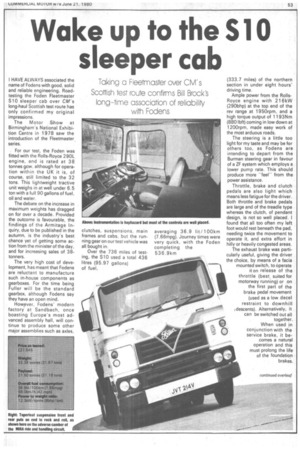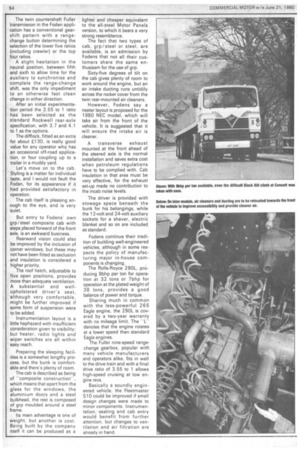Wake up to the S10 sleeper cab
Page 55

Page 56

If you've noticed an error in this article please click here to report it so we can fix it.
I HAVE ALWAYS associated the name of Fodens with good, solid and reliable engineering. Roadtesting the Foden Fleetmaster 810 sleeper cab over CM's long-haul Scottish test route has only confirmed my original impressions.
The Motor Show at Birmingham's National Exhibition Centre in 1978 saw the introduction of the Fleetmaster. series.
. For our test, the Foden was fitted with the Rolls-Royce 290L engine, and is rated at 38 tonnes gcw, although for operation within the UK it is, of course, still limited to the 32 tons. This lightweight tractive unit weighs in at well under 6.5 ton with a full 90 gallons of fuel, oil and water.
The debate on the increase in maximum weights has dragged on for over a decade. Provided the outcome is favourable, the findings of the Armitage Inquiry, due to be published in the autumn, is the industry's best chance yet of getting some action from the minister of the day, and for increasing sales of 38tonners.
The very high cost of development, has meant that Fodens are reluctant to manufacture such in-house components as gearboxes. For the time being Fuller will be the standard gearbox, although Fodens say they have an open mind.
However, Fodens' modern factory at Sandbach, once boasting Europe's most advanced assembly hall, will continue to produce some other major assemblies such as axles, clutches, suspensions, main frames and cabs, but the running gear on our test vehicle was all bought in.
Over the 736 miles of testing, the S10 used a total 436 litres (95.97 gallons) of fuel,
averaging 36.9 lit/100km (7.66mpg). Journey times were very quick, with the Foden completing the 536.9km (333.7 miles) of the northern section in under eight hours' driving time.
Ample power from the Rolls Royce engine with 216kW (290bhp) at the top end of the rev range at 1950rpm, and a high torque output of 1193Nm (880 lbft) coming in low down at 1200rpm, made easy work of the most arduous roads.
The steering is a little too light for my taste and may be for others too, as Fodens are intending to depart from the Burman steering gear in favour of a ZF system which employs a lower pump rate. This should produce more "feel" from the power assistance.
Throttle, brake and clutch pedals are also light which means less fatigue for the driver. Both throttle and brake pedals are large and of the treadle type whereas the clutch, of pendant design, is not so well placed. I found that all too often my left foot would rest beneath the pad, needing twice the movement to operate it, and extra effort in hilly or heavily congested areas.
The exhaust brake was parti cularly useful, giving the driver the choice, by means of a facia mounted switch, to Operate it on release of the throttle (best, suited for motorway running) or on the first part of the brake pedal movement (used as a low decel restraint to downhill descents). Alternatively, it can be switched out all together. When used in conjunction with the service brake, it be comes a natural operation and this must prolong the life of the foundation brakes. The twin countershaft Fuller transmission in the Foden application has a conventional gearshift pattern with a rangechange button determining the selection of the lower five ratios (including crawler) or the top four ratios.
A slight hesitation in the neutral position, between fifth and sixth to allow time for the auxiliary to synchronise and complete the range-change shift, was the only impediment to an otherwise fast clean change in either direction.
After an initial experimentation period the 3.55 to 1 ratio has been selected as the standard Rockwell rear-axle specification, with 3.7 and 4.1 to 1 as the options.
The difflock, fitted as an extra for about £130, is really good value for any operator who has an occasional off-road application, or four coupling up to a trailer in a muddy yard.
Let's move on to the cab. Styling is a matter for individual taste, and I would not fault the Foden, for its appearance if it had provided satisfactory in operation.
The cab itself is pleasing enough to the eye, and is very quiet.
But entry to Fodens' own grp/steel composite cab with steps placed forward of the front axle, is an awkward business.
Rearward vision could also be improved by the inclusion of corner windows, but these may not have been fitted as seclusion and insulation is considered a higher priority.
The roof hatch, adjustable to five open positions, provides more than adequate ventilation. A substantial and wellupholstered driver's seat, although very comfortable, might be further improved if some form of suspension were to be added.
Instrumentation layout is a little haphazard with insufficient consideration given to visibility; but heater, radio lights and wiper switches are all within easy reach.
Preparing the sleeping facilities is a somewhat lengthy process, but the bunk is comfortable and there's plenty of room.
The cab is described as being of "composite construction'', which means that apart from the glass for the windows, the aluminium doors and a steel bulkhead, the rest is composed of grp moulded around a steel frame.
Its main advantage is one of weight, but another is cost. Being built by the company itself it can be produced as a lighter and cheaper equivalant to the all-steel Motor Panels version, to which it bears a very strong resemblance.
The fact that two types of cab, grp/steel or steel, are available, is an admission by Fodens that not all their customers share the same enthusiasm for the use of grp.
Sixty-five degrees of tilt on the cab gives plenty of room to work around the engine, but an air intake ducting runs untidily across the rocker cover from the twin rear-mounted air cleaners.
However, Fodens say a neater layout is proposed for the 1980 NEC model, which will take air from the front of the vehicle. It is suggested that it will ensure the intake air is cleaner.
A transverse exhaust mounted at the front ahead of the steered axle is the normal installation and saves extra cost when petroleum regulations have to be complied with. Cab insulation in that area must be very effective, for the exhaust set-up made no contribution to the incab noise levels.
The driver is provided with stowage space beneath the bunk for his belongings, while the 12-volt and 24-volt auxiliary sockets for a shaver, electric blanket and so on are included, as standard.
Fodens continue their tradition of building well-engineered vehicles, although in some respects the policy of manufacturing major in-house components is changing, The Rolls-Royce 290L, producing 9bhp per ton for operation at 32 tons or 7bhp for operation at the plated weight of 38 tons, provides a good balance of power and torque.
Sharing much in common with the less-powerful 265 Eagle engine, the 290L is covered by a two-year warranty with no mileage limit. The denotes that the engine rotates at a lower speed than standard Eagle engines.
The Fuller nine-speed rangechange gearbox, popular with many vehicle manufacturers and operators alike, fits in well to the drive train and with a final drive ratio of 3.55 to 1 allows high-speed cruising at low engine revs.
Basically a soundly engineered vehicle, the Fleetmaster S10 could be improved if small design changes were made to minor components. Instrumentation, seating and cab entry would benefit from further attention, but changes to ventilation and air filtration are already in hand,




























































































































